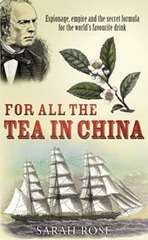 I’ve been on a bit of a reading spree: next up is “For all the tea in China” by Sarah Rose. This is the story of Robert Fortune and his trips to China in the mid-nineteenth century to obtain tea plants and the secret of tea manufacture for the East India Company to use in India.
I’ve been on a bit of a reading spree: next up is “For all the tea in China” by Sarah Rose. This is the story of Robert Fortune and his trips to China in the mid-nineteenth century to obtain tea plants and the secret of tea manufacture for the East India Company to use in India.
Robert Fortune (1812-1880) was a botanist with a modest background. Starting his working life at the Royal Botanic Garden Edinburgh, he later became Curator of the Chelsea Physic Garden. These were relatively poorly paid posts, however there were few such positions to support a professional botanist without their own means of support. He made several substantial visits to the Far East, funded by the Horticultural Society of London and the British East India Company. He died a wealthy man in large part through the wide range of plant introductions he had made, as well as through sales of artefacts he had acquired in the Far East. The list of introductions is well worth a skim through for the modern gardener:
The East India Company had been given a monopoly of trade to the Far East in 1600, through this monopoly they had built a lucrative trade in silk and tea from China, as well as effectively running India. The trades from China were matched with trades into China of opium from India, by the middle of the 19th century addiction to opium was a significant problem in China. The volume of trade it brought made the East India Company a very significant contributor to British government income (of order 10%). Although there are now many global corporations, the East India Company was one of the first and in many ways most powerful. The company was ultimately to lose its dominance following the Indian Mutiny in 1858, and was finally wound up in 1874. The mutiny was likely the cumulation of a long process since the monopoly that the East India Company enjoyed was not popular with free-marketeers who were starting to come to the fore.
At the time of Fortune’s first trip to China in 1845 the English had long been drinking tea imported from China, in exchange for opium grown in India. The English drank both green and black teas, although unlike the Chinese they added milk and sugar (obtained from another British colonial outpost). The Chinese were keen to keep the secret of both the tea plant, and its manufacture into tea leaves for making tea. Whilst the British, in particular the East India Company were keen to get these secrets believing (correctly) that tea would grow well in Himalayan India and would make a good profit. Some tea was already being grown in the Assam district of India but is was derived from inferior Chinese plants. The tea plant is Camellia sinensis a close relative of the decorative camellias of which Fortune also introduced some species.
Before Fortune’s first visit to China it had not even been established that black tea and green tea came from the same plant, but were processed differently. His trips required considerable subterfuge: Westerners had only recently been allowed into anywhere other than a limited number of ports in China, as a result of the first Opium War and Fortune’s activities went considerably beyond what was allowed even under these revised regulations. One of Fortune’s discoveries was that green tea had been coloured by the Chinese for the export market using Prussian Blue (which is toxic) and gypsum. Following a couple of false starts he was eventually able to transport a large number of highest quality tea plant seedlings to Darjeeling in India, as well as providing skilled tea makers and extensive notes on the tea making process.
The key to Fortune’s success in shipping out tea plants from China were Wardian cases, these are essentially sealed glass environments containing soil and some water. Plants, or more importantly, troublesome seeds could be sealed into these containers and as long as they remained sealed, and given some light there would be a good chance of their biological cargo surviving a lengthy sea journey through a range of climates. Prior to this discovery long distance transplantations were tricky. Nowadays we see Kew Gardens as largely a place of leisure, but in the 19th century it was very much at the heart of the Empire in terms of facilitating the movement of plants around the world for commercial reasons. This type of activity was also an early interest of the Royal Society.
It’s difficult not to draw parallels between the state sanctioned opium trade which the United Kingdom used to support, and its current attitude to drug smuggling. Nor between the industrial espionage of the East India Company in the 19th century, and the current issues with the Chinese approach to intellectual property.
I found the sections of the book reporting Fortune’s travels a bit unfulfilling: they seemed to be a sequence of travel anecdotes involving the mischief caused by his Chinese servants – this style does affect other parts of the books. However, more generally the book made me curious to know more about the East India Company, the Opium Wars and so forth and I felt I’d learnt something about the introduction of tea to India.
I’m tempted by Fortune’s book: Three years’ wanderings in the Northern Provinces of China

 The Immortal Life of Henrietta Lacks
The Immortal Life of Henrietta Lacks

